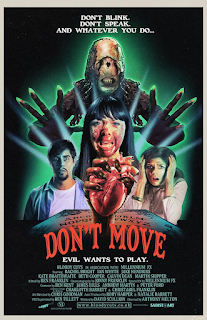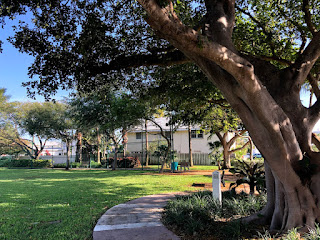Short Film Research: Don't Move
Common sounds found in film:
Suspenseful Music:
- Tense and eerie musical scores or soundtracks are commonly used to build suspense and enhance the overall atmosphere of horror films.
Creaking or Footsteps:
- Sounds of creaking floors, footsteps, or other subtle noises can create a sense of unease and anticipation.
Breathing or Whispering:
- Soft, ominous breathing or whispering sounds are often employed to heighten tension and evoke a feeling of being watched or followed.
Jump Scares:
- Sharp, sudden sounds or music cues, known as jump scares, are frequently used to startle the audience and intensify moments of fright.
Heartbeat Pounding:
- The sound of a heartbeat, either normal or irregular, can be used to convey fear and anxiety, especially during intense scenes.
Door Creaks or Slamming:
- Sounds of doors creaking open or slamming shut can add to the suspense, especially in scenes involving unexpected entrances or exits.
Unsettling Ambient Sounds:
- Ambient sounds such as distant screams, howling wind, or other unnatural noises contribute to the eerie ambiance of horror films.
String Instruments:
- String instruments, such as violins, are often used to create a sense of tension and anticipation in horror film scores.
Growls or Roars:
- Depending on the nature of the horror, growls or roars may be utilized to evoke a sense of danger or the presence of a menacing force.
Silence and Sound Absence:
- The absence of sound, followed by a sudden loud noise, can be a powerful technique to catch the audience off guard.
Distorted or Dissonant Sounds:
- Sounds that are distorted, dissonant, or otherwise abnormal can create a sense of the supernatural or the uncanny.
Costumes:
- Characters may wear clothing that reflects the tone of the film. In horror, costumes may include everyday attire, possibly disheveled or distressed to convey a sense of urgency or fear.
Lighting:
- Horror films often use lighting to create a dark and atmospheric mood. Low-key lighting, shadows, and strategic use of light can enhance suspense and contribute to the eerie atmosphere.
Actors:
- Expressions and body language of actors play a significant role in horror films. Facial expressions conveying fear or distress, as well as physical reactions to the unknown, contribute to the overall tension.
Makeup and Hair:
- Makeup may be used to create visual effects, such as wounds or other elements that contribute to the horror theme. Hairstyles may be designed to fit the characters and the mood of the film.
Props:
- Props in a horror film can include items that enhance the sense of fear or the supernatural. For example, objects related to rituals, religious symbols, or items with a mysterious significance may be used.
Setting:
- The setting in a horror film is crucial for establishing the atmosphere. It might include locations like dimly lit houses, abandoned buildings, or other places that evoke a sense of isolation and vulnerability.
Sound Design:
- While not strictly part of the CLAMPS framework, sound design is integral to mise-en-scène in horror films. Sounds of creaking doors, footsteps, and ambient noises contribute to the overall atmosphere.
Special Effects:
- Practical effects or visual effects may be used to create supernatural or frightening elements. The visual representation of fear-inducing elements is essential for the mise-en-scène in horror.
Color Palette:
- The color palette can contribute to the mood of the film. Dark and muted colors are often used to enhance the ominous and suspenseful atmosphere in horror.
Natural Elements:
- Depending on the setting, natural elements such as fog, rain, or moonlight can be incorporated into the mise-en-scène to add to the visual and atmospheric appeal.
Quick Cuts:
- Quick cuts between shots can create a sense of urgency and intensity, especially during suspenseful or frightening moments.
Jump Cuts:
- Abrupt and unexpected jump cuts can be employed to surprise the audience and heighten the impact of scary scenes.
Montage:
- Montage sequences might be used to build tension or convey information rapidly. Quick cuts in a montage can enhance the pacing and atmosphere.
Match Cuts:
- Match cuts may be utilized to create visual connections between different shots, enhancing the continuity and flow of the narrative.
Crosscutting:
- Crosscutting between different characters or storylines can increase suspense, especially when there's a simultaneous threat.
Slow Motion:
- Slow-motion sequences can be employed to emphasize specific moments, create a dreamlike atmosphere, or heighten the impact of scares.
Sound Editing and Mixing:
- The combination of editing and sound design is crucial in horror. Well-timed edits paired with eerie or unsettling sounds contribute significantly to jump scares and overall tension.
Silence and Sound Absence:
- The use of silence or a sudden absence of sound can be strategically employed before a scare, intensifying the impact of a subsequent loud noise or visual shock.
Cutting on Action:
- Editing cuts that occur during moments of action or movement can create a seamless and dynamic flow, enhancing the impact of the scenes.
Parallel Editing:
- Cutting between different locations or events happening simultaneously can build suspense and anticipation.
Flickering Lights or Visual Distortions:
- Editing techniques that involve flickering lights, visual distortions, or glitches can contribute to the eerie and unsettling atmosphere in horror films.
- Elements I liked in the film:
Suspenseful Atmosphere:
- "Don't Move" was praised for creating and maintaining a tense and suspenseful atmosphere throughout the film. The overall mood and pacing contributed to a heightened sense of fear.
Effective Use of Sound:
- The film's sound design received positive feedback for its ability to enhance the horror experience. Well-timed sounds, including creaking, footsteps, and ambient noises, contributed to the overall sense of dread.
Clever Editing Techniques:
- Viewers appreciated the film's editing techniques, including quick cuts and jump scares, which were effective in delivering frightening moments and keeping the audience on edge.
Strong Performances:
- The actors' performances, including their expressions and reactions, were praised for effectively conveying fear and tension. Convincing performances contributed to the audience's immersion in the story.
Compact Storytelling:
- As a short film, "Don't Move" was commended for delivering a compelling and complete narrative within a limited runtime. The concise storytelling was seen as effective and engaging.
Visual Impact:
- The visual elements, including cinematography and mise-en-scène, were highlighted for their impact on the overall horror experience. The use of lighting and setting contributed to the film's visual appeal.
Creativity in Concept:
- The film's concept, which involves a supernatural or horror element, was appreciated for its creativity. Viewers found the premise intriguing and unique within the horror genre.
Suspenseful Climax:
- The climax of the film, featuring intense and suspenseful sequences, was often mentioned positively. The payoff at the end of the narrative added to the overall satisfaction for viewers.
Effective Use of Setting:
- The choice of setting and the way it was utilized in the film were praised. The environment contributed to the overall mood and heightened the tension in key scenes.
Impactful Ending:
- The ending of the film was often cited as a strong point. A well-executed and impactful conclusion can leave a lasting impression on viewers, and "Don't Move" succeeded in delivering a memorable ending.
Viral Success:
- The film gained attention online and achieved viral success, contributing to its popularity. The positive reception from audiences led to increased visibility and recognition.
- Elements I didn't like in the film:
Predictability:
- Some viewers may have found certain plot developments or scares to be predictable. Horror enthusiasts, especially those familiar with common horror tropes, may have anticipated certain elements.
Limited Character Development:
- Due to the short runtime typical of short films, character development might have been limited. Viewers who prefer more in-depth exploration of characters may have found the film lacking in this aspect.
Reliance on Jump Scares:
- While jump scares are a common element in horror films, some viewers may feel that an overreliance on this technique can lead to predictability or a lack of sustained tension.
Ambiguity in Storytelling:
- The film's approach to storytelling, particularly if it involves ambiguity or lack of clear explanations, might not have resonated with all viewers. Some audiences prefer more concrete resolutions or explanations.
Short Runtime Constraints:
- As a short film, "Don't Move" had limitations in terms of runtime. Some viewers may have desired a longer duration to further develop the plot, characters, or certain elements of the story.
Preference for Longer Atmospheric Build-Up:
- While the film was praised for its suspenseful atmosphere, some viewers might have preferred a more extended atmospheric build-up before the climax.
Visual Effects Limitations:
- Short films often have budget constraints, and viewers who have high expectations for sophisticated visual effects may have noticed the limitations in this regard.
Preference for More Complex Narratives:
- Viewers who appreciate complex or layered narratives might have found the simplicity of the plot or the absence of subplots to be less engaging.
Lack of Exposition:
- The film may not provide a detailed explanation of certain supernatural elements or the backstory. Some viewers may have wanted more exposition to understand the mythology or context behind the events.
Individual Horror Preferences:
- Preferences in horror vary widely, and what works for some may not work for others. Some viewers may simply not connect with the specific style or approach taken in "Don't Move."


Comments
Post a Comment